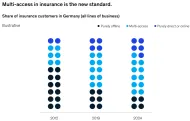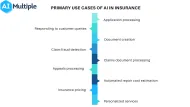Process Mining Insurance: Use Cases & Best Practices in 2024
Insurance companies struggle with risk, service and compensation of complex products under cost pressure, prescriptive regulations and standards. Insurance companies can leverage process mining to optimize their processes to improve customer experience, compliance and control while decreasing the operation costs.
This article explains use cases and best practices insurance companies should consider while applying business mining in their businesses.
The top use cases of process mining in insurance include:
Map risk assessment/underwriting
Insurance companies set their premium by calculating risks which are the likelihoods of potential client’s claims. When the risk is calculated high, they might lose their customers. In contrast, underestimated risks lead to losses for insurers. Process mining monitors and maps the entire underwriting process, identifying existing risks.
Ensure Compliance
Process mining provides an in-depth examination of individual processes (e.g. time cycle, cost, issues, reports) and insights into non-compliant processes. It compares actual processes against the law and policies and ensures that the internal controls are working through conformance check. To discover how process mining enhances compliance and internal auditing:
Ease Fraud detection
It was estimated that insurance fraud costs more than $40 Billion in the US alone. Process mining can help detect possible fraud by monitoring ongoing organizational processes. Thus, process mining can generate risk profiles for fraudulent reporting by discovering processes containing customer behaviour data.
Accelerate claim processing and accuracy
Process mining can help optimizing workflows in the claim processes. The time between claim submission and provider response can take a long time due to repetitive steps such as:
- Aggregating client data
- Classifying information (e.g. type of accident, reports written by police on accident)
- Taking action
- Responding to customers via call or email
For example, when the first notice of loss, damage or theft of an insured asset, the claim settlement process involves several steps until the final decision is made, which is slow. Process mining can help identify tedious tasks for automation via RPA or chatbots to decrease the period across these steps. In some case studies, companies leveraging process mining could shorten throughput time by ~30%.
Reduce quote-to-bind ratio
The quote-to-bind ratio measures the conversion of quotes to legally binding policies. Process mining can discover inefficiencies in processes, resulting in losing leads and increasing the quote-to-bind ratio. These inefficiencies can be related to:
- Customer communication: For instance, process mining can discover communication channels (e.g. email, Slack, chatbot) that customers prefer and those they do not use. Thus, it can reveal insights on first contact resolution by analyzing these channels.
- Business analytics: Process mining can uncover repetitive analytics tasks to be automated via analytics software.
Optimize back office operations
Process mining can allow insurance companies to identify bottlenecks in the back office operations (e.g. IT, HR) and improve the communication flow between the back and front offices.
For example, insurance companies worldwide with back and front offices can employ the root cause analysis to determine why certain tasks are carried out incorrectly.
Discover automation opportunities
Process mining can discover processes that can be improved with automation, such as repetitive steps and reworks. By reducing the time spent on tedious tasks, insurance companies reduce their costs and increase claim process efficiency and accuracy.
A common automation technology in the insurance industry is RPA, for more you can learn more about RPA use cases for insurance processes.
Best practices for insurance firms
Insurance leaders who want to implement process mining must follow best practices, including:
Identify business goals and required tasks
You must specify business goals and identify the tasks before employing process mining. For example, Suncorp, an Australian insurance company, has partnered with a process mining consultant to discover why it takes so long to do simple tasks. Though they had a specific goal to increase their time inefficiency in small tasks, it was still challenging for the consultants because it was not clear what simple tasks meant.
They overcome this issue by redefining the small task definition based on the net payout amount. The simple tasks are the ones that fall under a certain threshold in terms of the revenue they generate. Also, by clarifying the concept, consultants enabled Suncorp to collect accurate data. Before, the insurance company’s data was collected randomly, whereas after defining simple tasks, they improved data collection.
Improve data quality
The insurance data is complex due to:
- multiple sub-processes
- noise (e.g. infrequent process variants)
- incomplete and inconsistent records of events.
For example, system users use the terms “natural hazard”, “storm flood”, or “flood” to define loss cause, which is confusing and influences process mining analysis results. Therefore, it is important to clean data, clarify these loss causes, and ensure it is ready to use before implementing process mining.
Filtering criteria
It would help if you prepared criteria for the filtering that depend on the target question and the data quality to apply this filtering in the process mining analysis. For instance, Suncorp insurance company asked why simple tasks take so long to complete, employing process mining. They filtered the tasks based on time during process mining as they wanted to investigate periods each simple task takes. However, their results were not accurate as the large gap between scheduling time and assignment time affected the analyses. Therefore, they had to change their filtering criteria into performance classes.
Performance classes were structured by the variables of claim departments, case duration and net payout amount. These filters allow placing the case in the four-dimensional chart where groups are:
- Simple Quick (SQ)
- Complex Slow (CS)
- Simple Slow (SS)
- Complex Quick (CQ)
Further reading
To learn more about process mining, tools and use cases, feel free to read:
If you believe your business can benefit from process mining tools, you can check our data-driven list of process mining software and other automation solutions.
Check out our comprehensive and constantly updated process mining case studies list to learn more real-life examples on process mining insurance.
And you can let us find you the right vendor:



Comments
Your email address will not be published. All fields are required.